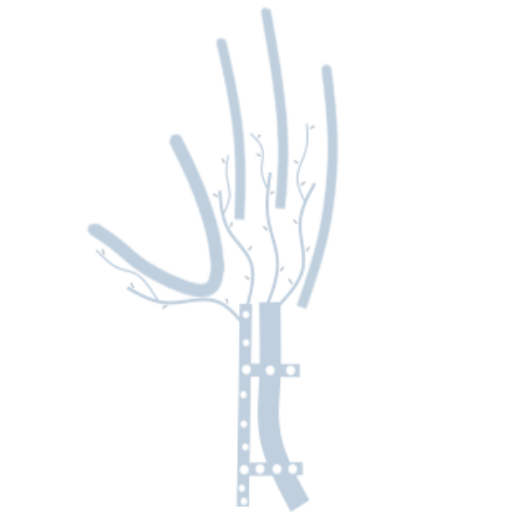A randomised controlled trial of cemented and cementless femoral components for metal-on-metal hip resurfacing
a bone mineral density study
Fuente
Este artículo es originalmente publicado en:
http://www.ncbi.nlm.nih.gov/pubmed/26637673?dopt=Abstract
http://www.bjj.boneandjoint.org.uk/content/97-B/12/1608.abstract
De:
Tice A1, Kim P1, Dinh L1, Ryu JJ1, Beaulé PE1.
Bone Joint J. 2015 Dec;97-B(12):1608-1614.
Todos los derechos reservados para:
©2015 The British Editorial Society of Bone & Joint Surgery.
Abstract
The primary purpose of this study of metal-on-metal (MoM) hip resurfacing was to compare the effect of using a cementless or cemented femoral component on the subsequent bone mineral density (BMD) of the femoral neck. This was a single-centre, prospective, double-blinded control trial which randomised 120 patients (105 men and 15 women) with a mean age of 49.4 years (21 to 68) to receive either a cemented or cementless femoral component. Follow-up was to two years. Outcome measures included total and six-point region-of-interest BMD of the femoral neck, radiological measurements of acetabular inclination, neck-shaft and stem-shaft angles, and functional outcome scores including the Harris hip score, the Western Ontario and McMaster Universities Osteoarthritis Index and the University of California at Los Angeles activity scale. In total, 17 patients were lost to follow-up leaving 103 patients at two years. There were no revisions in the cementless group and three revisions (5%) in the cemented group (two because of hip pain and one for pseudotumour). The total BMD was significantly higher in the cementless group at six months (p < 0.001) and one year (p = 0.01) than in the cemented group, although there was a loss of statistical significance in the difference at two years (p = 0.155). All patient outcomes improved significantly: there were no significant differences between the two groups. The results show better preservation of femoral neck BMD with a cementless femoral component after two years of follow-up. Further investigation is needed to establish whether this translates into improved survivorship. Cite this article: Bone Joint J 2015;97-B:1608-14.
Resumen
El propósito principal de este estudio del recubrimiento de cadera metal sobre metal (MoM) fue comparar el efecto de utilizar un cemento o componente femoral cementado en la densidad mineral ósea posterior (BMD) del cuello femoral. Este fue un solo centro, ensayo controlado prospectivo, doble ciego que asignó al azar a 120 pacientes (105 hombres y 15 mujeres) con una edad media de 49,4 años (21 a 68) para recibir un componente femoral cementado o no cementado. El seguimiento fue de dos años. Las medidas de resultado incluyeron la DMO total y de seis puntos región de intereses del cuello femoral, mediciones radiológicas de inclinación acetabular, cuello-eje y ángulos de tallo de árbol, y las puntuaciones de resultado funcional incluyendo la puntuación de cadera de Harris, los Western Ontario y McMaster Universidades Índice osteoartritis y la Universidad de California en Los Ángeles escala de actividad. En total, 17 pacientes se perdieron durante el seguimiento dejando a 103 pacientes a los dos años. No hubo revisiones en el grupo sin cemento y tres revisiones (5%) en el grupo cementado (dos a causa de dolor en la cadera y una para pseudotumor). El total de la DMO fue significativamente mayor en el grupo sin cemento a los seis meses (p <0,001) y un año (p = 0,01) que en el grupo cementado, aunque hubo una pérdida de significación estadística en la diferencia a los dos años (p = 0,155 ). Todos los resultados de los pacientes mejoraron significativamente: no hubo diferencias significativas entre los dos grupos. Los resultados muestran una mejor preservación de la DMO del cuello femoral con un componente femoral no cementado después de dos años de seguimiento. Se necesita más investigación para establecer si esto se traduce en una mejora de la supervivencia.
©2015 The British Editorial Society of Bone & Joint Surgery.
Resumen
El propósito principal de este estudio del recubrimiento de cadera metal sobre metal (MoM) fue comparar el efecto de utilizar un cemento o componente femoral cementado en la densidad mineral ósea posterior (BMD) del cuello femoral. Este fue un solo centro, ensayo controlado prospectivo, doble ciego que asignó al azar a 120 pacientes (105 hombres y 15 mujeres) con una edad media de 49,4 años (21 a 68) para recibir un componente femoral cementado o no cementado. El seguimiento fue de dos años. Las medidas de resultado incluyeron la DMO total y de seis puntos región de intereses del cuello femoral, mediciones radiológicas de inclinación acetabular, cuello-eje y ángulos de tallo de árbol, y las puntuaciones de resultado funcional incluyendo la puntuación de cadera de Harris, los Western Ontario y McMaster Universidades Índice osteoartritis y la Universidad de California en Los Ángeles escala de actividad. En total, 17 pacientes se perdieron durante el seguimiento dejando a 103 pacientes a los dos años. No hubo revisiones en el grupo sin cemento y tres revisiones (5%) en el grupo cementado (dos a causa de dolor en la cadera y una para pseudotumor). El total de la DMO fue significativamente mayor en el grupo sin cemento a los seis meses (p <0,001) y un año (p = 0,01) que en el grupo cementado, aunque hubo una pérdida de significación estadística en la diferencia a los dos años (p = 0,155 ). Todos los resultados de los pacientes mejoraron significativamente: no hubo diferencias significativas entre los dos grupos. Los resultados muestran una mejor preservación de la DMO del cuello femoral con un componente femoral no cementado después de dos años de seguimiento. Se necesita más investigación para establecer si esto se traduce en una mejora de la supervivencia.
©2015 The British Editorial Society of Bone & Joint Surgery.
KEYWORDS:
Cemented vs. Cementless; Hip Resurfacing; Randomised Controlled Trial (RCT)
PMID: 26637673 [PubMed – as supplied by publisher]

